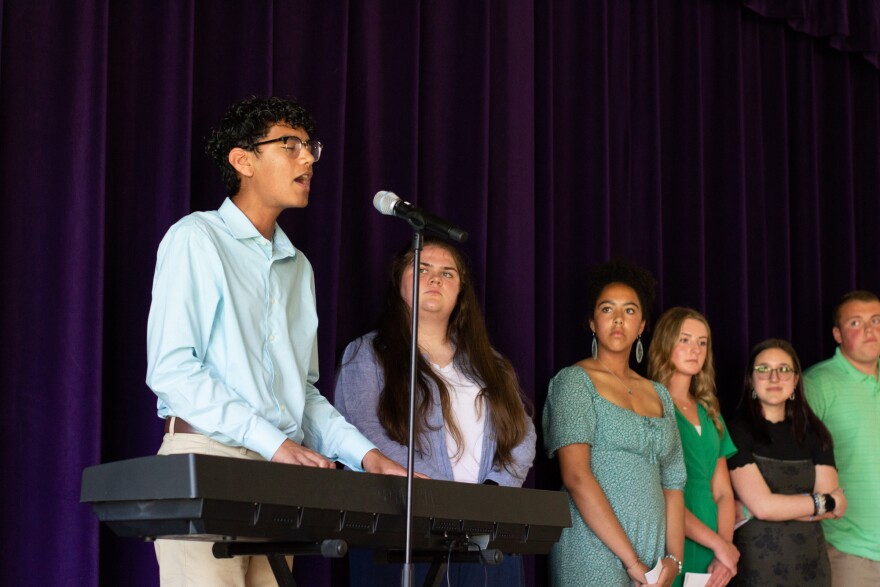A group of Valley high schoolers recently traveled to Farmville to visit historical sites and people from one of the cases that became Brown v. Board of Education. The twist? The teenagers were the tour guides. WMRA's Randi B. Hagi reports.
In 1951, an African American student at R.R. Moton High School in Farmville organized a student strike. Her name was Barbara Johns. For two weeks, she and her 400-some classmates boycotted classes in protest of their school's poor condition – which was markedly inferior to the white school in town. They gained the support of NAACP attorneys Oliver Hill and Spottswood Robinson, who filed the federal lawsuit Davis v. Prince Edward County.
BEAU DICKENSON: And that goes before the steps of the Supreme Court of this nation in 1954, three years later, as the most landmark Supreme Court case that touched every single community in this country.

Beau Dickenson, the social studies supervisor for Rockingham County Public Schools, has been bringing students to the Moton Museum since 2015 to learn this history in the very building where it happened.
DICKENSON: The schools that you go to are not segregated, Jim Crow schools. You live this experience. You are part of this narrative. You are part of this legacy.
Twenty-four students from the county's four high schools have been researching this history in an independent study course. Last Thursday, they presented what they learned – to one another, their teachers, and to some of the strikers themselves.
One of the attendees was Joan Johns Cobbs – younger sister of the strike leader, Barbara.
[people talking in the background]

JOAN JOHNS COBBS: I just think it's great that they are doing this. I think it will teach them a lot, too, about the history, and maybe inspire some of them to do something themselves.
Halla Baugher, a junior at East Rockingham High School, was part of the first group that presented.
HALLA BAUGHER: We were super nervous, being the first people, and especially since her sister's here! We were so stressed that we weren't going to get all the information right! … It is genuinely just such an interesting movement, and there's so many individuals to learn about.
They gave an overview of Johns's life and her motivation to seek a just and quality education. Then, Juan Andres Garcia performed an original song that they wrote.

[keyboard playing]
JUAN ANDRES GARCIA [singing]: I won't be minimized, and I won't be defined by your society. I just want to be free …
Cobbs was really touched.
COBBS: I was so impressed with that song. The lyrics and how it was all put together and the rhythm of it. It was beautiful. It was wonderful.
The group also toured downtown Farmville, including the First Baptist Church.
DICKENSON: It was in the basement of this church where the students met somewhat secretly with Oliver Hill and Spottswood Robinson …

In 1959, Prince Edward County closed all of their public schools for five years, trying to forestall integration. They created private schools for white students only. Broadway student Jordan Passarelli continues the story.
JORDAN PASSARELLI: Every school across the county had slammed its doors in the faces of young Black students … temporarily denying them of an education and leaving their futures hanging in uncertain liminality. L. Francis Griffin and his supporters could not stand for this, so they designed free schools for the children of Prince Edward County.
Another group from Spotswood built a Jenga tower. Chloe Leach used it to demonstrate how the students' demands for equality disrupted segregation.
CHLOE LEACH: Rattling up the balance that keeps it together, causing it to fall. [blocks crash down] Rebuild the system better.

I asked Dickenson how the state's history standards could affect these field trips. He said the draft adopted by the Virginia Board of Education earlier this month preserves students' ability to learn about issues such as segregation.
DICKENSON: There are certainly chapters of our history that we celebrate, that make us feel patriotic, and that should be central to our curriculum, but at the same time we have to own the more uncomfortable parts of our past and understand why they happened. … And within those stories, like Moton, we have incredible moments of pride in how people, Americans, responded to those challenges.
Back in November, the board rejected a draft that was criticized by several education organizations.
DICKENSON: The initial draft of those standards deleted Martin Luther King, Jr. from elementary school. … It referred to native, indigenous peoples as America's first immigrants. Those mistakes do harm to students and communities.

Dickenson noted that he was not taught about school segregation as a kid in Rockingham County. The former student strikers seemed heartened that this generation knows what they experienced. Rev. J. Samuel Williams told the group –
REV. J. SAMUEL WILLIAMS, JR.: The Moton Museum – don't forget this – is a movement. All of you are a part of a movement. You don't know what it's going to bring forward. … Be active in your community.
[Juan Andres Garcia singing]
Joan Johns Cobbs added that, despite all she went through, she couldn't imagine going to school in fear of gun violence – and called on today's youth to pick up that mantle.


